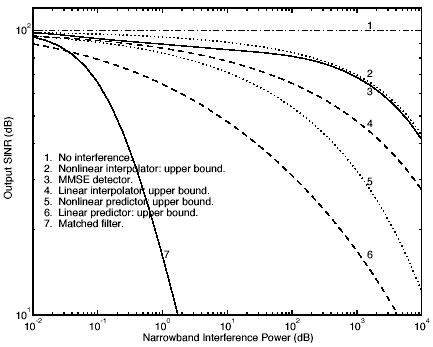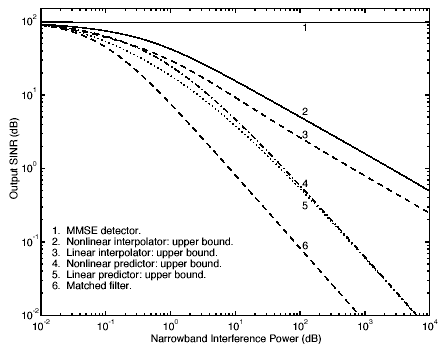7.5 Performance Comparisons of NBI Suppression Techniques
| In Section 7.4, we have derived closed-form expressions for the performance measure (SINR) of the linear MMSE detector against three types of NBI. In this section we compare its performance against NBI with performance bounds for the linear and nonlinear NBI suppression methods discussed in Sections 7.2 and 7.3. 7.5.1 Matched FilterFor the conventional detector, the received signal r in (7.67) is sent directly to a single filter matched to the spreading sequence (i.e., w = s ). The mean and variance at the output of the matched filter are Equation 7.119 Equation 7.120 The output SINR is then given by Equation 7.121 7.5.2 Linear Predictor and InterpolatorAs mentioned before, linear or nonlinear predictive NBI suppression methods are based on the following idea. Since the spread-spectrum signal has a nearly flat spectrum, it cannot be predicted accurately from its past values without explicit use of knowledge of the spreading code. On the other hand, the interfering signal, being narrowband , can be predicted accurately. These methods essentially form a replica of the NBI, which can be subtracted from the received signal to enhance the wideband components . The linear methods have involved primarily the use of linear transversal prediction or interpolation filters to create the NBI replica. Such a filter forms a linear prediction of the received signal based on a fixed number of previous samples, or a linear interpolation based on a fixed number of past and future samples. This estimate is subtracted from the appropriately timed received signal to obtain the error signal to be used as input to the SS user signature sequence correlator. Let S i ( w ) denote the power spectral density of the NBI signal. The following output SINR upper bounds for the linear prediction/interpolation methods can be found in [310, 311]: Equation 7.122 Equation 7.123 7.5.3 Nonlinear Predictor and InterpolatorFor narrowband interference added to a spread-spectrum signal in an AWGN environment, the prediction of the interferer takes place in the presence of both Gaussian and non-Gaussian noise. The non-Gaussian noise is the spread-spectrum signal itself. In such a non-Gaussian environment, linear methods are no longer optimal, and nonlinear techniques offer improved suppression capability over linear methods, as demonstrated in Section 7.3. Essentially, the nonlinear filters provide decision feedback that suppresses the spread-spectrum signal from the observations. When the decision feedback is accurate, the filter adaptation is done in essentially Gaussian noise (i.e., observations from which the spread-spectrum signal has been removed). Based on the discussion above, we can obtain similar SINR upper bounds for the nonlinear predictive/interpolative methods. The idea is that we assume that the decision feedback part of the nonlinear filter accurately estimates the SS signal, and the SS signal is always subtracted from the observations, so that the NBI signal is estimated only in the presence of Gaussian noise. More specifically , consider the signal model (7.5). Assume that for the purpose of estimating the NBI signal, a genie provides an SS-signal-free observation A linear predictor or interpolator is then employed to obtain and estimate n of the NBI signal, which is then subtracted from the received signal to form the decision statistic for the SS data bit b , Equation 7.124 where Equation 7.125 Substituting the lower bounds for the mean-square prediction errors Equation 7.126 Equation 7.127 Now assume that the NBI is a p th-order AR signal, given by (7.94). Its power spectral density function is given by Equation 7.128 Substituting (7.128) into (7.127) and letting s Equation 7.129 Notice that this is the same output SINR value for the linear MMSE detector when the NBI is an AR signal in the absence of noise, given by (7.106). 7.5.4 Numerical ExamplesIn order to compare the NBI suppression capabilities of the various techniques described above, we consider two numerical examples. In the first example, the narrowband interferer is a second-order AR signal with both poles at 0.99 (i.e., f 1 = -1.98 and f 2 = 0.9801). The noise power is held constant at s 2 = -20 dB (relative to the SS signal after despreading), while the interference power is varied from -20 dB to 40 dB (all relative to a unity SS power signal). The spreading signature sequence is a length-31 m -sequence. In Fig. 7.13 we plot the output SINR performance of various NBI suppression techniques for this example. We see that the linear MMSE detector significantly outperforms the linear predictor/interpolator, and it almost achieves the loose SINR upper bound for the nonlinear interpolator. Figure 7.13. Comparison of the performance against the NBI of different NBI suppression techniques. The narrowband interferer is a second-order AR signal with both poles at 0.99. The noise power is held constant at s 2 = -20 dB relative to the SS signal after despreading, while the interference power is varied from -20 dB to 40 dB relative to the SS signal. The spreading signature sequence is a length-31 m -sequence. In the second example, the narrowband interferer is a digital signal with m = 4. Assuming that the digital NBI signal has a rectangular pulse waveform, the autocorrelation function of the chip-sampled NBI signal is then Equation 7.130 where L = Equation 7.131 The performance of various methods against the digital NBI in this example is plotted in Fig. 7.14. The noise power is 20 dB below the SS signal power (after despreading), while the NBI signal power is varied from -20 dB to 40 dB relative to the SS signal power. It is seen that in this case the linear MMSE detector almost completely removes the NBI energy at the output, and the output SINR is held at 20 dB irrespective of the NBI power. This can be readily explained by (7.118). The other techniques are all clearly inferior to the linear MMSE detector in suppressing the digital NBI, and their performance degrades as the NBI power increases . Figure 7.14. Comparison of the performance against the NBI of different NBI suppression techniques. The narrowband interferer is a digital signal with m = 4. The noise power is held constant at s 2 = -20 dB relative to the SS signal after despreading, while the interference power is varied from -20 dB to 40 dB relative to the SS signal. The spreading signature sequence is a length-31 m -sequence. |
EAN: 2147483647
Pages: 91
- Intrinsic and Contextual Data Quality: The Effect of Media and Personal Involvement
- Healthcare Information: From Administrative to Practice Databases
- A Hybrid Clustering Technique to Improve Patient Data Quality
- Relevance and Micro-Relevance for the Professional as Determinants of IT-Diffusion and IT-Use in Healthcare
- Development of Interactive Web Sites to Enhance Police/Community Relations







 0, we get the SINR upper bound for the nonlinear interpolator when the NBI is an AR signal in the absence of background noise:
0, we get the SINR upper bound for the nonlinear interpolator when the NBI is an AR signal in the absence of background noise: 



 , and the power spectral density is
, and the power spectral density is 
